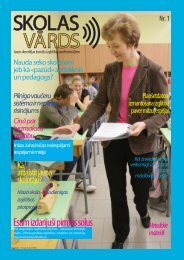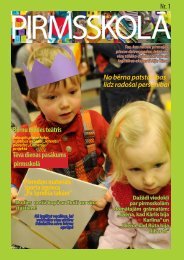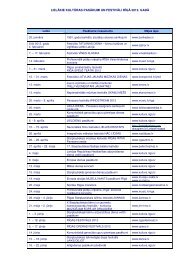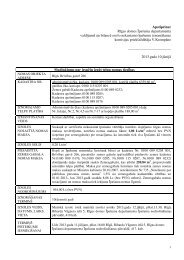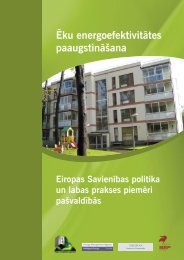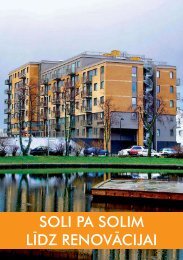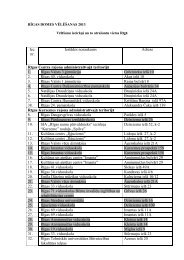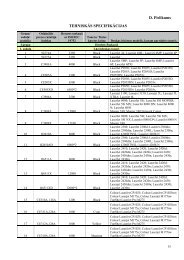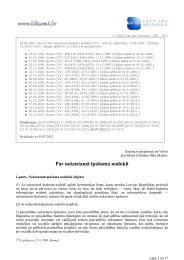Riga - European Capital of Culture 2014 candidate
Riga - European Capital of Culture 2014 candidate
Riga - European Capital of Culture 2014 candidate
- No tags were found...
Create successful ePaper yourself
Turn your PDF publications into a flip-book with our unique Google optimized e-Paper software.
VEF <strong>Culture</strong> PalaceDzintari Concert Hall in JūrmalaNot far from <strong>Riga</strong>, on the sea coast, is Jūrmala, a historic resort town, and one <strong>of</strong> itscalling cards is the Dzintari Concert Hall. The story <strong>of</strong> the Concert Hall starts as far backas the late 19 th century, and its construction was initiated by the Swimming Society <strong>of</strong>the time – a non-governmental association that was concerned about various mattersregarding the town’s maintenance. Dzintari Concert Hall was built as one <strong>of</strong> the firstopen-type concert halls and its acoustic and constructive solution is one <strong>of</strong> the bestachievements in this sector. The open side edges allow the space to interact with the surroundinglandscape <strong>of</strong> Jūrmala dune park. There are 2024 seats in the Large Hall, and arestaurant with approximately 200 seats. During the history <strong>of</strong> the Concert Hall, variousfamous <strong>European</strong> musicians, circus artists and theatres have performed here. The mostpopular annual events today include the international festival “Summertime”, organisedby the world known <strong>Riga</strong> opera singer, Inese Galante, the international new singer competition“New Wave”, symphonic, contemporary music and youth concerts.<strong>Riga</strong>’s Cooperation Partner Town SiguldaTomass and Martins Dukurs, are well-known skeleton athletes. In cooperation with theLatvian Olympic movement, in <strong>2014</strong>, the 3 rd Latvian Winter Olympics will take place withwide inhabitant participation.Gūtmanis CaveGūtmanis Cave is the largest sandstone cave in the Baltics. Its formation began 10 000years ago, with the water currents eroding the sandstone cliff following the Ice Age. Anancient cult location. A protected geological object. Cave height – 10m, width – 12m,depth – 18,8m. Also notable for its inscriptions on the walls, that have been created morethan 200 years ago. There are several tales and legends linked to the Cave. The mostwell-known legend is a romantic and tragic tale <strong>of</strong> Rose <strong>of</strong> Turaida.Gūtmanis CaveTuraidaThe museum reserve <strong>of</strong> Turaida is a territory measuring 42 hectares, in which 11 th -20 thcentury monuments to nature, history, archaeology and culture can be found: the medievalcastle <strong>of</strong> Turaida with exhibitions, the Lutheran Church, built in 1750, a commemorativesite to Rose <strong>of</strong> Turaida, Dainu Hill – an exhibition <strong>of</strong> 26 sculptures dedicated toLatvian folk songs, the household centre <strong>of</strong> Turaida Manor, Jāņkalns (Midsummer Hill).In <strong>2014</strong>, summer solstice events will take place here, and a campaign dedicated to the800 th anniversary <strong>of</strong> Turaida Castle, “Living Pictures”.Sigulda Castle RuinsDzintari Concert Hall in JūrmalaThe open-air stage <strong>of</strong> Sigulda was chosen as a venue for events with the intention <strong>of</strong> creatinga particularly vivid and relaxed atmosphere. The open-air stage among the castleruins is the most beautiful open-air stage in Latvia, where the Latvian Theatre Festivaland Opera Music Festival, together with the vibrant nature <strong>of</strong> the ancient valley <strong>of</strong> theRiver Gauja, will provide spectators and listeners with moments <strong>of</strong> unique cultural pleasure,spiritual rebirth, peace and harmony. High-quality music, performed by artists withworld renown, with the vibrant and romantic natural backdrop <strong>of</strong> the ancient valley <strong>of</strong> theGauja, sounds unique.Sigulda Bobsleigh and Toboggan TrackTrack was built in 1986 after a project elaborated by Leipzig Scientific Centre for Sport.The origins <strong>of</strong> the bobsleigh in Latvia can be found in Sigulda in the late 19 th century, whenthe owner <strong>of</strong> Sigulda Manor, Grand Duke, Nikolai Kropotkin built the first 900m long bobsleightrack with one curve. Today, it is one <strong>of</strong> 17 bobsleigh tracks in the world, measuring1200 metres long, with 16 curves and a maximum speed <strong>of</strong> 125 km/h. A large-scaleinternational competition takes place on the Track – the World Cup in TobogganingSports. Many Latvian bobsleigh and toboggan drivers come from Sigulda. The brothers,164 165




